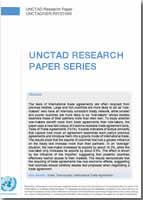
Trade agreements are not just about trade. They have become increasingly popular, and increasingly complex. They have moved from conventional tariff negotiations to include provisions on labour, development, environment, gender and ecommerce among others.
Has this increase in complexity and frequency made the world more cooperative or more competitive? A cursory look does not reveal any obvious patterns. The United States of America and Canada, for example, have been bound together by trade agreements since 1988. Yet the Softwood Lumber dispute in the WTO has simmered since 2002 and continues today. At the same time, the United States and Canada regularly vote together in non-economic matters.
To explore this question, we turn to the highest level of foreign policy - the United Nations General Assembly (UNGA). As all countries receive a single vote in the UNGA, voting offers a clear signal of foreign policy positions, and alignment of interests can be directly measured.
In this paper we show that there are clear political spillovers from trade cooperation. Using a dataset from United Nations General Assembly votes, we illustrate that countries that cooperate in trade, also cooperate in politics.
Our analysis tilts the balance towards trade agreements as a tool for political cooperation. UNGA voting patterns between trading partners change when a trade agreement is enacted. Overall, regional trade agreements (RTAs) make countries 4 percent more likely to register the same vote in UNGA resolutions.
Alignment of voting in the UNGA is not cheap. It is costly for countries to prepare resolutions, conduct plurilateral consultations and lobby. The presence of these preparations increases both the absolute and relative costs of "disagree" votes and makes them relatively rare. Yet, RTAs effects on voting are more pronounced in these "disagree" situations. RTA partners vote in against motions together in an additional 7 percent of votes. This nuance provides further significance to the relationship we find.
Another dimension of the argument is that deeper forms of RTAs have greater impacts on voting synchronization. This result is strongest for Customs Unions, where overall voting synchronization increases by 11 percent among the RTA members, and by 22 percent for the disagree votes.
This paper is organized as follows: Section 2 discusses the question that we are interested in, Section 3 presents the data and the voting similarity index used for the empirical estimations in Section 4 and Section 5 concludes.


